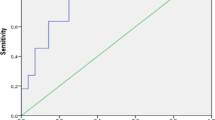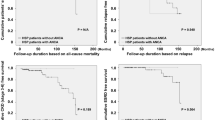Abstract
Objective
To retrospectively investigate clinico-pathological features and outcomes of patients with renal involvement in propylthiouracil (PTU)-associated antineutrophil cytoplasmic autoantibody (ANCA) vasculitis (PTU-AAV).
Methods
Clinico-pathological features and outcomes of 12 patients (female 11, average age 32.4 ± 13.8 years) who developed AAV after treatment with PTU were collected and analyzed. ANCA was detected by both immunofluorescence (IF) and enzyme linked immunosorbent assay (ELISA). All patients had renal biopsy.
Results
Twelve patients received PTU for 2–264 months (median 42 months) when PTUAAV was diagnosed. All patients had positive serum P-ANCA, 11 of them were MPO-ANCA, 1 was MPO and PR3-ANCA double positive. All patients presented with hematuria and proteinuria, 5 of them had gross hematuria, urine protein was 1.9 ± 1.6 g/24 h, 7 of 12 (58.3 %) patients had renal dysfunction, among them 3 needed initial renal replacement therapy. Renal biopsy showed pauci-immune segmental necrotizing crescentic glomerulonephritis in ten patients, segmental necrotizing glomerulonephritis superimposed on membranous nephropathy in two patients. All patients withdrew PTU and received steroid and immunosuppressive therapy. After a median follow-up of 42 months (range 21–86), 3 patients developed to ESRD, 7 patients entered complete renal remission. Serum ANCA turned negative only in 2 patients, 10 patients had persistent positive serum ANCA. Three patients relapsed with the elevation of serum ANCA level.
Conclusion
Renal damage of PTU-AAV could be pauci-immune necrotizing crescentic glomerulonephritis, and necrotizing glomerulonephritis coexisted with membranous nephropathy. Most patients had persistent positive serum ANCA and had a risk of relapse and progression to ESRD even after PTU withdrawl and immunosuppressive therapy.

Similar content being viewed by others
References
Chen M, Gao Y, Guo XH et al (2012) Propylthiouracil-induced antineutrophil cytoplasmic antibody-associated vasculitis. Nat Rev Nephrol. 8:476–483
Gao Y, Zhao MH (2009) Review article: drug-induced anti-neutrophil cytoplasmic antibody-associated vasculitis. Nephrology. 14:33–41
Choi HK, Merkel PA, Walker AM et al (2000) Drug-associated antineutrophil cytoplasmic antibody-positive vasculitis: prevalence among patients with high titers of antimyeloperoxidase antibodies. Arthritis Rheum 43:405–413
Fujieda M, Hattori M, Kurayama H et al (2002) Clinical features and outcomes in children with antineutrophil cytoplasmic autoantibody-positive glomerulonephritis associated with propylthiouracil treatment. J Am Soc Nephrol 13:437–445
Hagen EC, Hoffman GS, Hunder GG et al (1994) Nomenclature of systemic vasculitides: proposal of an international consensus conference. Arthritis Rheum 37:187–192
Hu W, Liu C, Xie H et al (2008) Mycophenolate mofetil versus cyclophosphamide for inducing remission of ANCA vasculitis with moderate renal involvement. Nephrol Dial Transpl 23:1307–1312
Hu W, Liu Z, Ji D et al (2006) Staphylococcal protein A immunoadsorption for Goodpasture’s syndrome in four Chinese patients. J Nephrol. 19:312–317
Yu F, Chen M, Gao Y et al (2007) Clinical and pathological features of renal involvement in propylthiouracil-associated ANCA-positive vasculitis. Am J Kidney Dis 49:607–614
Gao Y, Chen M, Ye H et al (2008) Long-term outcomes of patients with propylthiouracil-induced antineutrophil cytoplasmic auto-antibody-associated vasculitis. Rheumatology (Oxford) 47:1515–1520
Hu WX, Liu ZH, Liu CB et al (2005) Prognosis of microscopic polyangiitis with renal involvement report of 60 Chinese patients. Chin Med J 118:2089–2092
Noh JY, Yasuda S, Sato S et al (2009) Clinical characteristics of myeloperoxidase antineutrophil cytoplasmic antibody-associated vasculitis caused by antithyroid drugs. J Clin Endocrinol Metab 94:2806–2811
Chen YX, Yu HJ, Ni LY et al (2007) Propylthiouracil-associated antineutrophil cytoplasmic autoantibody-positive vasculitis: retrospective study of 19 cases. J Rheumatol 34:2451–2456
Grcevska L, Polenakovic M, Petrusevska G (2000) Membranous nephropathy associated with thyroid disorders. Nephron. 86:534–535
Chen YX, Zhang W, Chen XN et al (2012) Propylthiouracil-induced antineutrophil cytoplasmic antibody (ANCA)-associated renal vasculitis versus primary ANCA-associated renal vasculitis: a comparative study. J Rheumatol 39:558–563
Ishii R, Imaizumi M, Ide A et al (2010) A long-term follow-up of serum myeloperoxidase antineutrophil cytoplasmic antibodies (MPO-ANCA) in patients with Graves disease treated with propylthiouracil. Endocr J 57:73–79
Ohtsuka M, Yamashita Y, Doi M et al (1997) Propylthiouracilinduced alveolar haemorrhage associated with antineutrophil cytoplasmic antibody. Eur Respir J 10:1405–1407
Helfgott SM, Smith RN (2002) Case records of the Massachusetts General Hospital. Weekly clinicopathological exercises. Case 21-2002. A 21-year-old man with arthritis during treatment for hyperthyroidism. N Engl J Med 347:122–130
Acknowledgments
This work was supported by the National Key Technology R&D Programm (2011BAI10B04).
Conflict of interest
The authors have no conflict of interest or financial relationships to disclose.
Author information
Authors and Affiliations
Corresponding author
Additional information
Y. Chen and H. Bao have contributed equally to the work and are to be considered co-first authors.
Rights and permissions
About this article
Cite this article
Chen, Y., Bao, H., Liu, Z. et al. Clinico-pathological features and outcomes of patients with propylthiouracil-associated ANCA vasculitis with renal involvement. J Nephrol 27, 159–164 (2014). https://doi.org/10.1007/s40620-014-0063-2
Received:
Accepted:
Published:
Issue Date:
DOI: https://doi.org/10.1007/s40620-014-0063-2




